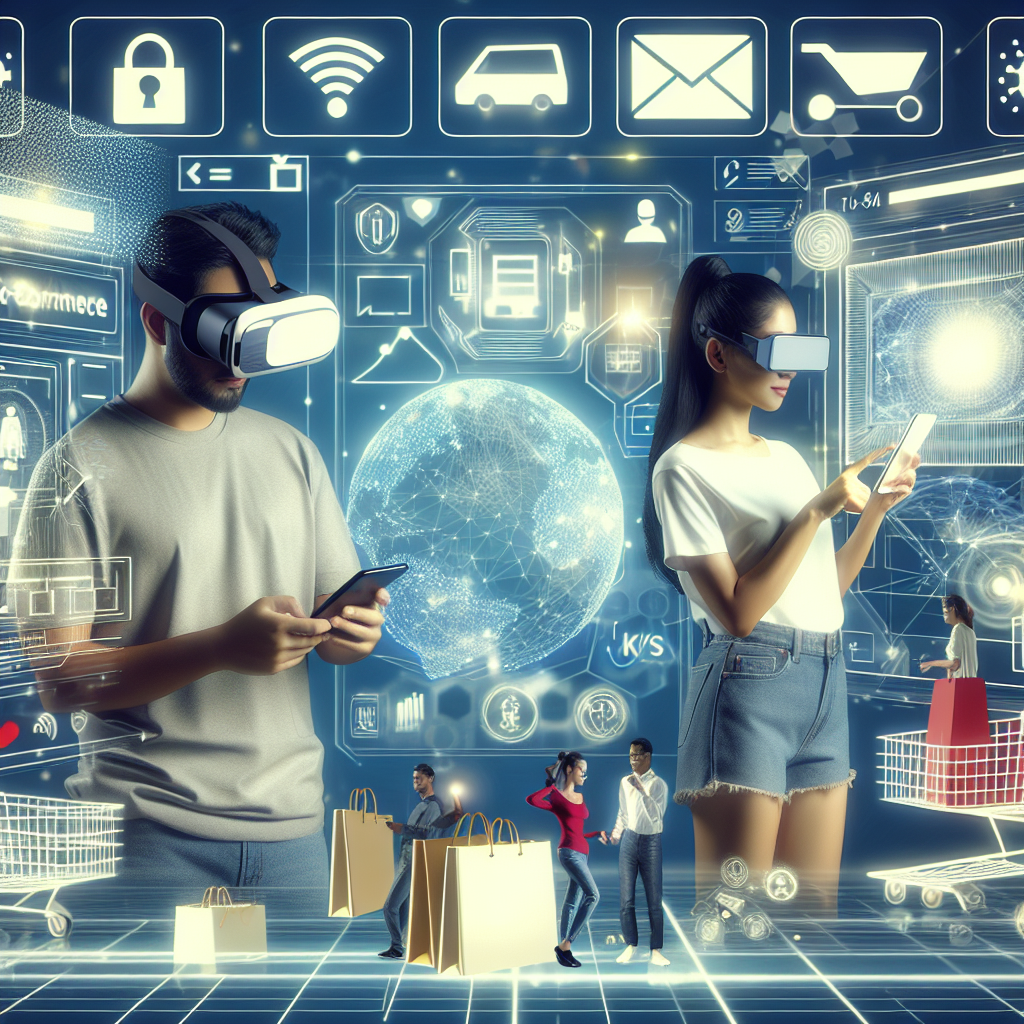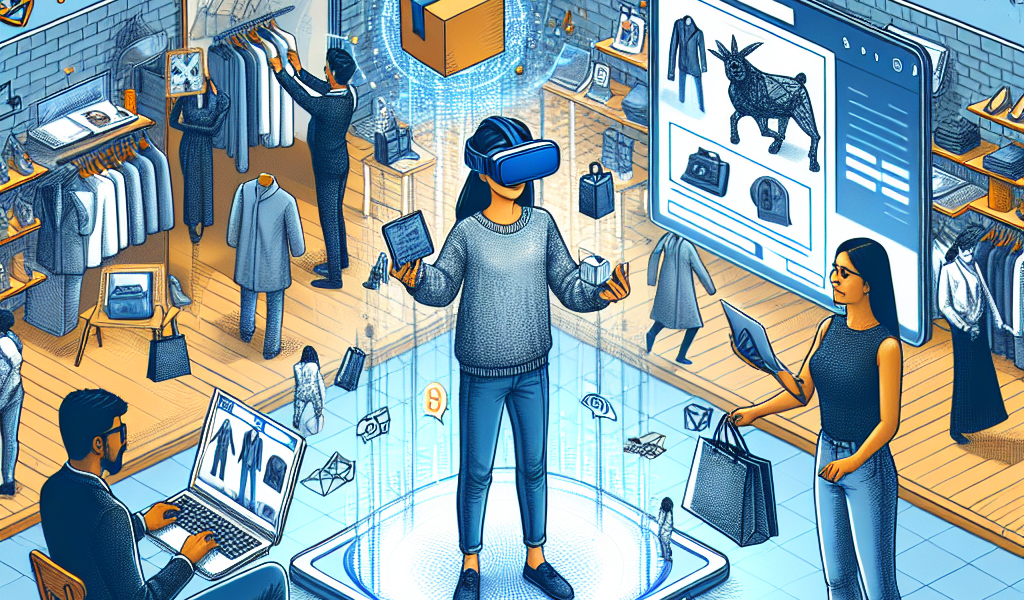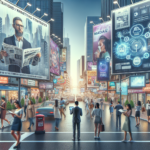-
Table of Contents
“Transforming Shopping: Augmented Reality Revolutionizes Retail and E-Commerce”
Introduction

Augmented Reality (AR) is revolutionizing the retail and e-commerce sectors by bridging the gap between online and offline shopping experiences. This technology overlays digital information onto the physical world, allowing consumers to visualize products in their real environment before making a purchase. AR enhances customer engagement, reduces return rates, and provides personalized shopping experiences, thereby driving sales and customer satisfaction. Retailers and e-commerce platforms are increasingly adopting AR to offer virtual try-ons, interactive product demonstrations, and immersive brand experiences, fundamentally transforming the way consumers shop and interact with brands.
Enhancing Customer Experience with Augmented Reality in Retail
Augmented Reality (AR) is revolutionizing the retail and e-commerce sectors by enhancing customer experiences in unprecedented ways. As technology continues to evolve, retailers are increasingly leveraging AR to bridge the gap between online and in-store shopping, offering consumers a more immersive and interactive experience. This transformation is not only reshaping how customers engage with products but also redefining the entire shopping journey.
One of the most significant impacts of AR in retail is its ability to provide a virtual try-before-you-buy experience. This feature allows customers to visualize products in their own environment before making a purchase. For instance, furniture retailers like IKEA have developed AR apps that enable users to see how a piece of furniture would look in their home. By simply pointing their smartphone camera at a space, customers can place a virtual piece of furniture in the room, adjust its position, and even change its color. This capability reduces the uncertainty and hesitation often associated with online shopping, leading to more confident purchasing decisions.
Moreover, AR is enhancing the apparel and beauty industries by allowing customers to virtually try on clothes, accessories, and makeup. Brands like Sephora and Warby Parker have introduced AR features in their apps that let users see how different products will look on them. This not only saves time but also enhances the overall shopping experience by making it more personalized and engaging. Customers can experiment with various styles and products without the need to physically visit a store, thus blending the convenience of online shopping with the tactile satisfaction of in-store experiences.
In addition to improving the shopping experience, AR is also proving to be a powerful tool for increasing customer engagement and loyalty. Retailers are using AR to create interactive and gamified experiences that captivate customers and encourage repeat visits. For example, some stores have implemented AR treasure hunts, where customers use their smartphones to find virtual items hidden throughout the store. These innovative approaches not only make shopping more enjoyable but also foster a deeper connection between the brand and the consumer.
Furthermore, AR is playing a crucial role in enhancing product information and education. By scanning a product with an AR-enabled device, customers can access detailed information, reviews, and even tutorials on how to use the product. This level of transparency and accessibility helps build trust and empowers customers to make informed decisions. For instance, a customer shopping for electronics can use AR to see a 3D model of a product, explore its features, and watch demonstration videos, all within the app.
The integration of AR in retail is also streamlining the supply chain and inventory management processes. Retailers can use AR to visualize and optimize store layouts, ensuring that products are displayed in the most effective manner. This technology can also assist in training employees by providing virtual simulations of various tasks, thereby reducing training time and costs.
Despite the numerous advantages, the adoption of AR in retail does come with challenges. High development costs, the need for advanced hardware, and concerns about data privacy are some of the hurdles that retailers must overcome. However, as technology continues to advance and become more accessible, these challenges are likely to diminish.
In conclusion, augmented reality is significantly enhancing the customer experience in retail and e-commerce by offering immersive, interactive, and personalized shopping experiences. By bridging the gap between the physical and digital worlds, AR is not only transforming how customers shop but also how retailers operate. As this technology continues to evolve, its impact on the retail industry is expected to grow, paving the way for a more innovative and customer-centric future.
Augmented Reality: Revolutionizing Online Shopping and E-Commerce
Augmented Reality (AR) is rapidly transforming the landscape of retail and e-commerce, offering a blend of the physical and digital worlds that enhances the shopping experience. This technology, which overlays digital information onto the real world through devices such as smartphones and AR glasses, is providing retailers with innovative ways to engage customers and drive sales. As consumers increasingly seek convenience and personalization, AR is emerging as a powerful tool to meet these demands.
One of the most significant impacts of AR in retail is its ability to bridge the gap between online and in-store shopping. Traditionally, online shopping has been limited by the inability to physically interact with products. However, AR addresses this limitation by allowing customers to visualize products in their own environment before making a purchase. For instance, furniture retailers like IKEA have developed AR apps that enable users to see how a piece of furniture would look in their home, ensuring that it fits both spatially and aesthetically. This not only enhances the customer experience but also reduces the likelihood of returns, which can be costly for retailers.
Moreover, AR is revolutionizing the way consumers try on products. In the fashion and beauty industries, virtual try-ons have become increasingly popular. Brands such as Sephora and Warby Parker offer AR experiences that let customers see how makeup or glasses will look on their face without physically trying them on. This technology is particularly valuable in the current climate, where health and safety concerns have made in-store shopping less appealing. By providing a virtual fitting room, AR helps retailers maintain engagement with their customers while adhering to social distancing guidelines.
In addition to enhancing the shopping experience, AR also offers significant benefits for marketing and brand engagement. Interactive AR advertisements can capture consumer attention more effectively than traditional ads. For example, a consumer might scan a QR code on a product package to unlock an AR experience that provides additional information, tutorials, or even a game. This level of interactivity not only makes the shopping experience more enjoyable but also fosters a deeper connection between the consumer and the brand.
Furthermore, AR is proving to be a valuable tool for data collection and analysis. By tracking how customers interact with AR features, retailers can gain insights into consumer preferences and behaviors. This data can then be used to personalize marketing efforts and improve product offerings. For instance, if a significant number of users are virtually trying on a particular style of clothing, a retailer might decide to stock more of that item or create similar designs. This level of customization can lead to increased customer satisfaction and loyalty.
Despite its many advantages, the adoption of AR in retail and e-commerce is not without challenges. The development and implementation of AR technology can be costly, and not all retailers have the resources to invest in it. Additionally, there is a learning curve for both retailers and consumers in terms of understanding and utilizing AR features effectively. However, as technology continues to advance and become more accessible, it is likely that these barriers will diminish.
In conclusion, augmented reality is poised to revolutionize the retail and e-commerce sectors by enhancing the shopping experience, improving marketing efforts, and providing valuable consumer insights. As retailers continue to explore and adopt AR technology, they will be better equipped to meet the evolving demands of consumers, ultimately driving growth and success in an increasingly competitive market.
The Role of Augmented Reality in Reducing Product Returns
Augmented Reality (AR) is revolutionizing the retail and e-commerce sectors, offering innovative solutions to long-standing challenges. One of the most significant issues faced by these industries is the high rate of product returns, which not only incurs substantial costs but also affects customer satisfaction and brand loyalty. AR technology is emerging as a powerful tool to mitigate this problem by enhancing the online shopping experience and providing customers with a more accurate representation of products before making a purchase.
To begin with, AR allows customers to visualize products in their real-world environment through their smartphones or AR-enabled devices. This capability is particularly beneficial for items such as furniture, home decor, and fashion, where the fit, size, and style are crucial factors in the purchasing decision. For instance, a customer can use an AR app to see how a new sofa would look in their living room or how a pair of shoes would fit on their feet. By providing a realistic preview, AR helps customers make more informed decisions, thereby reducing the likelihood of returns due to mismatched expectations.
Moreover, AR enhances the product discovery process by offering interactive and immersive experiences. Traditional online shopping often relies on static images and text descriptions, which can be insufficient for conveying the true essence of a product. In contrast, AR can present products in 3D, allowing customers to examine them from various angles and even interact with them. This level of engagement not only makes the shopping experience more enjoyable but also ensures that customers have a comprehensive understanding of what they are buying. Consequently, this reduces the chances of dissatisfaction and returns.
In addition to improving product visualization, AR can also assist in providing accurate sizing information. One of the common reasons for returns in the fashion industry is incorrect sizing. AR applications can offer virtual fitting rooms where customers can try on clothes virtually, ensuring that they select the right size before making a purchase. This technology can analyze the customer’s body measurements and recommend the best fit, thereby minimizing the risk of returns due to size issues.
Furthermore, AR can play a crucial role in educating customers about product features and usage. Complex products, such as electronics or home appliances, often come with detailed specifications and instructions that can be overwhelming for customers. AR can simplify this by overlaying digital information onto the physical product, guiding customers through its features and demonstrating how to use it effectively. This not only enhances the customer experience but also reduces the likelihood of returns due to misunderstandings or improper usage.
The integration of AR in retail and e-commerce also fosters greater customer confidence and trust. When customers feel assured that they are making well-informed decisions, they are less likely to return products. Retailers that adopt AR technology demonstrate a commitment to innovation and customer satisfaction, which can strengthen brand loyalty and encourage repeat business.
In conclusion, augmented reality is proving to be a game-changer in reducing product returns in the retail and e-commerce sectors. By offering realistic product visualization, interactive experiences, accurate sizing information, and educational support, AR addresses many of the common reasons for returns. As this technology continues to evolve and become more accessible, it is likely to play an increasingly vital role in enhancing the online shopping experience and driving customer satisfaction.
How Augmented Reality is Shaping the Future of Retail Marketing
Augmented Reality (AR) is revolutionizing the retail and e-commerce landscape, offering a transformative experience that bridges the gap between physical and digital shopping. As technology continues to evolve, retailers are increasingly leveraging AR to enhance customer engagement, streamline the shopping process, and ultimately drive sales. This innovative approach is not only reshaping consumer expectations but also redefining the strategies businesses employ to capture and retain their audience.
One of the most significant impacts of AR in retail marketing is its ability to provide immersive and interactive experiences. By overlaying digital information onto the physical world, AR allows customers to visualize products in their real environment before making a purchase. For instance, furniture retailers like IKEA have developed AR apps that enable users to see how a piece of furniture would look in their home, ensuring that it fits both spatially and aesthetically. This level of interactivity reduces the uncertainty often associated with online shopping, thereby increasing consumer confidence and reducing return rates.
Moreover, AR is enhancing the personalization of the shopping experience. Retailers can use AR to offer tailored recommendations based on individual preferences and behaviors. For example, beauty brands such as Sephora and L’Oréal have introduced AR-powered virtual try-on features, allowing customers to experiment with different makeup products and shades in real-time. This personalized approach not only makes the shopping experience more enjoyable but also helps customers make more informed decisions, leading to higher satisfaction and loyalty.
In addition to improving the customer experience, AR is also proving to be a powerful tool for marketing and advertising. Brands are creating AR-based campaigns that engage users in novel ways, fostering a deeper connection with the audience. For example, Pepsi’s AR bus shelter campaign in London created an illusion of extraordinary events happening on the street, captivating passersby and generating significant buzz on social media. Such innovative campaigns not only capture attention but also encourage user-generated content, amplifying the brand’s reach and impact.
Furthermore, AR is facilitating a seamless integration of online and offline shopping experiences. Retailers are using AR to create interactive in-store displays that provide additional product information, reviews, and recommendations. This integration helps bridge the gap between the convenience of online shopping and the tactile experience of physical stores. For instance, clothing retailers are implementing AR mirrors that allow customers to see how different outfits would look without physically trying them on, thus enhancing the in-store experience while saving time.
The adoption of AR in retail marketing is also driving significant advancements in data collection and analysis. By tracking user interactions with AR features, retailers can gain valuable insights into consumer preferences and behaviors. This data can be used to refine marketing strategies, optimize product offerings, and improve overall customer service. As a result, businesses can make more informed decisions and stay ahead of market trends.
However, the integration of AR in retail is not without its challenges. The development and implementation of AR technology require substantial investment, and there is a learning curve for both retailers and consumers. Additionally, ensuring a seamless and bug-free AR experience is crucial, as technical glitches can detract from the user experience and damage brand reputation. Despite these challenges, the potential benefits of AR in retail marketing are immense, and as technology continues to advance, its adoption is likely to become more widespread.
In conclusion, augmented reality is poised to play a pivotal role in the future of retail marketing. By offering immersive, personalized, and interactive experiences, AR is transforming the way consumers shop and interact with brands. As retailers continue to explore and innovate with AR technology, the line between physical and digital shopping will increasingly blur, leading to a more integrated and engaging retail landscape.
Conclusion
The impact of augmented reality (AR) on retail and e-commerce is profound, revolutionizing the way consumers interact with products and brands. AR enhances the shopping experience by allowing customers to visualize products in their own environment, try on virtual clothing, and receive personalized recommendations. This technology increases customer engagement, reduces return rates, and boosts conversion rates by providing a more immersive and interactive shopping experience. Retailers and e-commerce platforms that leverage AR can gain a competitive edge, improve customer satisfaction, and drive sales growth. As AR technology continues to evolve, its integration into retail and e-commerce is likely to become even more widespread, further transforming the industry.





